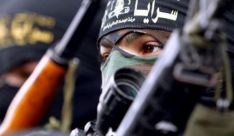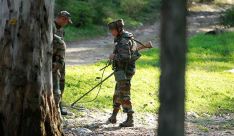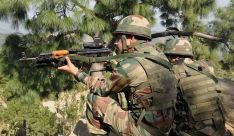In January last year, Islamic State released a nine-minute audio clip of a speech given by Abu Muhammad al-Adnani, its chief spokesman and designated emir of Syria. The speech began with the invocation of jihadist themes and the customary threats of hellfire and damnation to apostates and the enemies of the extremist group. Then came the big announcement, about four minutes into the clip. “We bring the mujahideen the good news of Islamic State’s expansion to Khurasan,” al-Adnani said in Arabic. “We call upon all monotheists in Khurasan to join the caravan of the Khilafah (the ‘caliphate’ established by IS chief Abu Bakr al-Baghdadi). So come to your state, O mujahideen, come to your Khilafah!”
The message drove Indian intelligence agencies into a tizzy, and rightly so. Khurasan is an ancient Islamic name for the vast territory that encompasses northeastern Iran, Afghanistan, Pakistan and parts of northwestern India. In the IS scheme of things (which ultimately aims to bring about the apocalypse, as experts have pointed out), Khurasan occupies pride of place: it is the prophesied scene of the great battle between believers and infidels, just before the apocalypse. “A king of Jerusalem would make a troop move forward towards Hindustan. The warriors [will] destroy the land of Hind and possess its treasures…. [They] would conquer all areas between east and west, and would stay in Hindustan till the emergence of Dajjal (an Antichrist-like figure in Islamic texts),” says one of the two hadiths, the oral traditions attributed to the Prophet Muhammad, about Khurasan.
The speech by al-Adnani made it clear that IS was ideologically committed to fulfilling the Khurasan prophecy. And, for the first time, intelligence agencies in India got a sneak-peek of what IS had in store for the country. “It is always good to know the enemy’s intentions, however unrealistic they are,” said a former Army officer who was part of the Military Intelligence, which inquired into incidents of Kashmiri youth waving IS flags in public in the past two years. “The Kashmir incidents are worrying and may represent a trend, as the MI report on the incidents pointed out. But I don’t think the whole IS strategy [for the region] is going to work. There are too many extremist factions, too many splinter groups whose ideology varies from IS and from each other. The IS plan to unite and mobilise these groups is beyond ambitious.”
According to Vijay Prashad, south Asia expert and professor of international studies at Trinity College in Connecticut, US, the worries in India about IS are overblown. “IS has ambitions in West Asia and—opportunistically—in North Africa,” he said in an email interview. “That is its locus. It is run by men who have both a very keen sense of their historical role (hence they talk of the vilayat of Khorasan) and a very limited sense of their immediate interest—to create a caliphate in Syria-Iraq and a base in Libya. This does not mean that other radicals might not be inspired to do their own activities in other lands such as in central Asia, Yemen or Afghanistan.”
So, the chances of IS actually mounting a war on India appear slim. But fears about its ideology taking root here are very much real. In the past two years, nearly two dozen Indians with suspected links to the radical group were taken into custody. The UAE deported eight Indians over the past few months for their alleged links to IS.
Indian intelligence agencies say 23 Indians travelled to conflict zones in the Middle East to join the IS, and that six of them died fighting in Iraq and Syria. What is especially worrying is the fact that IS, with its well-oiled social media campaign, has been able to attract a section of the youth in India. Reports say as many as 150 persons in states like Andhra Pradesh, Telangana, Karnataka, Kerala and Maharashtra, which have significant Muslim population, are reportedly under surveillance “for their alleged online links to IS”.
Experts, however, insist that there is no need to panic. “There have been only two instances where there was information that anybody from Maharashtra had gone to join IS,” Niket Kaushik, inspector-general, Maharashtra Anti-Terrorism Squad, told THE WEEK. “The instances where offences were registered are only two. Two cases and five persons [were charged]. Though it is worrisome, I would not say that there is any widespread influence of IS ideology [among Muslims].”
But could the number of people allegedly lured by the IS ideology suggest that IS is gaining ground in India? “These five youth going and joining IS is not a representation of any popularity of the IS ideology in the community,” said Kaushik. “The community has condemned these acts…. And I don’t know whether this [fear of Muslims in India being radicalised by IS ideology] is just an apprehension, or is backed by data.”
Muslims in India have openly criticised IS and its ideology. Last September, more than 1,000 religious leaders issued a joint fatwa against IS, saying its activities were “absolutely absurd and accursed”. “Islam is a religion of peace,” said Ashraf Moulavi, vice president of the All India Imams Council. “It does not espouse violence, in any form or by any means. No text or tenet in Islam, be it the Quran or the hadiths, encourages followers to adopt the path of violence.”
IS, however, has made wanton violence and destruction its hallmark. Three months before he released his Khurasan speech, al-Adnani had called on Muslims in France and Canada to find infidels and punish them by smashing their heads with rocks, poisoning them, running them over with cars and destroying their crops. The Khurasan speech itself exhorts believers to “threaten, frighten, terrorise and kill” infidels. But, curiously, in both the speeches, al-Adnani stops short of giving a reason for carrying out the violence, other than invoking various hadiths.
“IS does not have any real-world political ideology; it sees itself largely as an agent of chaos,” said the former Army officer. “That is why it may not appeal to militant groups in the subcontinent, who are focused on achieving political ends, such as separating Kashmir from India, imposing dictatorships and so on. The so-called Khurasan shura [a council comprising 12 provincial militant leaders appointed by IS] would not last a fortnight if they [the leaders] had a chance to meet.”
IS may not be what intelligence officers call a ‘clear and present danger’ for India, but that does not mean that there is no need be vigilant. “We need to be alert,” said Kaushik. “We cannot afford to let our guard down.”
According to Vijay Prashad, India has its share of complex problems that are more important than the IS threat. “The unresolved issue of Kashmir and the internal problems with minorities are fodder for opportunists,” he said. “If there is a real cause for concern, it is that the government of India continues to push sections of its own population into the corner. If these people do wear the colours of IS at some point, it would largely be because of the failure of the government in creating space for all Indians, and not because Abu Bakr al-Baghdadi sent his legions to the country.”












